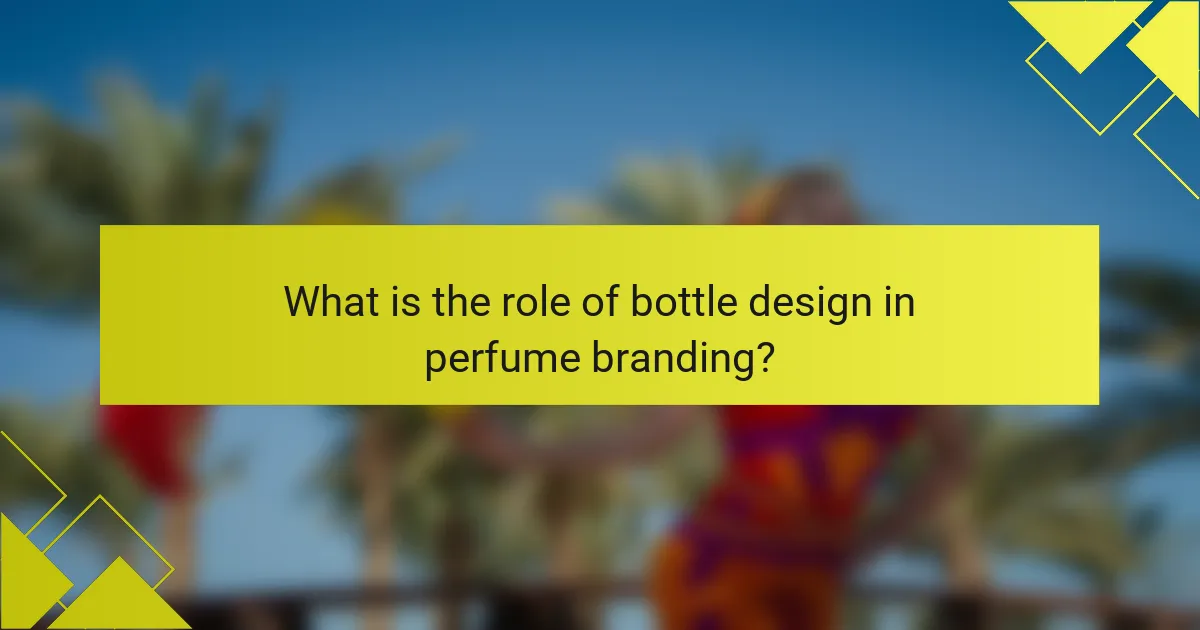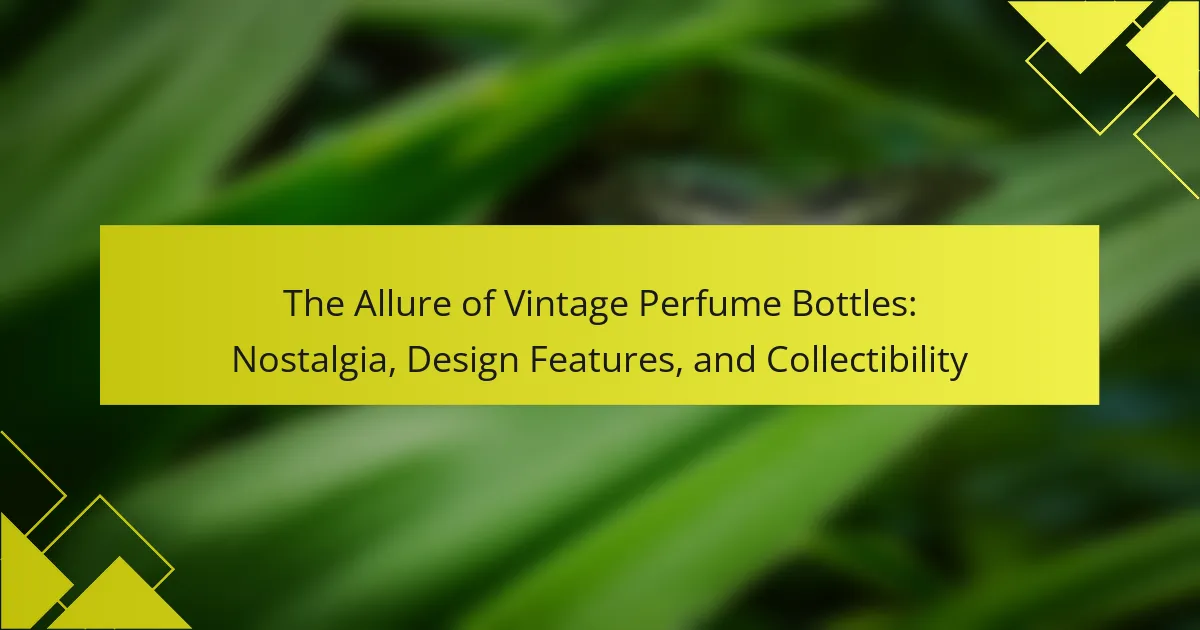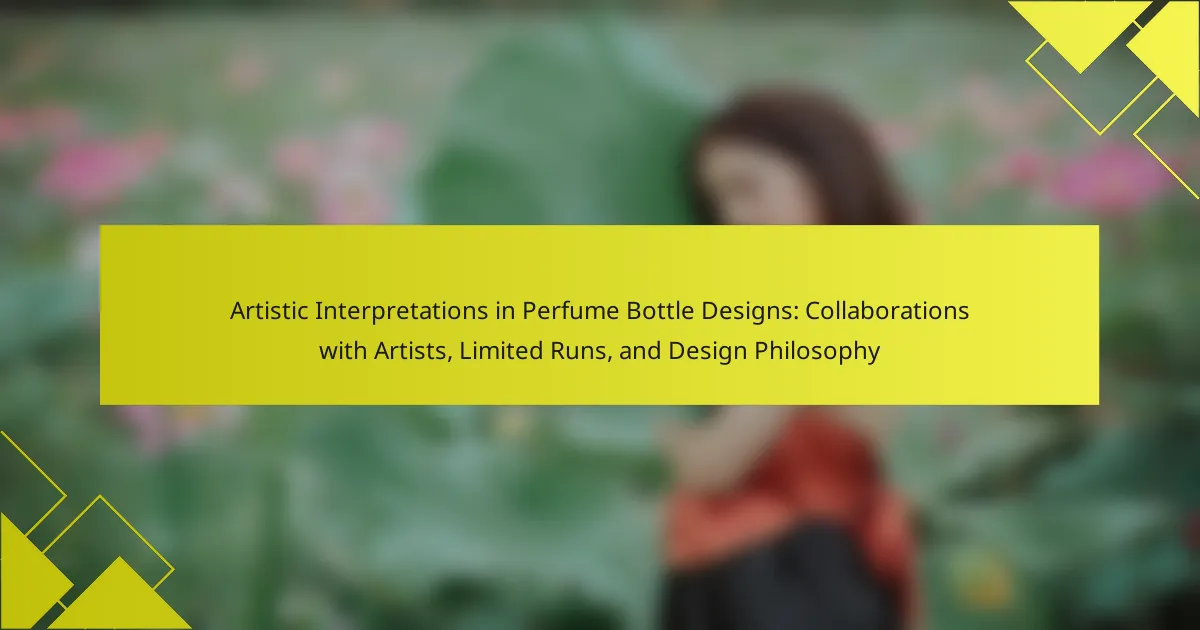
What is the role of bottle design in perfume branding?
Bottle design plays a crucial role in perfume branding by establishing a visual identity. It serves as the first point of interaction between the consumer and the product. Unique bottle shapes and colors can evoke emotions and convey the fragrance’s essence. For instance, luxury brands often use elegant designs to reflect sophistication and exclusivity.
Research shows that 70% of purchasing decisions are influenced by packaging design. This highlights the importance of a well-thought-out bottle design in attracting consumers. Additionally, bottle design can enhance shelf appeal in retail environments. A distinctive bottle can stand out among competitors, making it memorable.
Overall, effective bottle design not only communicates brand values but also influences consumer perception and purchasing behavior.
How does bottle design influence visual identity in perfume branding?
Bottle design significantly influences visual identity in perfume branding. It serves as the first point of contact for consumers. Unique shapes and materials can evoke specific emotions and associations. For instance, a sleek, modern bottle may suggest sophistication. In contrast, a vintage design might evoke nostalgia.
The design also reflects brand values and target demographics. Luxury brands often invest in intricate designs to convey exclusivity. Research shows that 75% of consumers judge a product by its packaging. This indicates the importance of bottle aesthetics in attracting attention.
Additionally, memorable bottle designs enhance brand recall. Consumers are more likely to remember and choose familiar designs. This reinforces the brand’s identity in a competitive market. Overall, effective bottle design is crucial for establishing a strong visual identity in perfume branding.
What are the key elements of bottle design that contribute to visual identity?
The key elements of bottle design that contribute to visual identity include shape, color, material, and labeling. The shape of a bottle influences its silhouette and can evoke specific emotions or brand associations. For example, sleek and tall designs often suggest elegance, while round shapes may convey softness. Color plays a crucial role in attracting attention and conveying brand personality; for instance, bold colors can signal energy and excitement, while muted tones may suggest sophistication. The material used, such as glass or plastic, impacts perceptions of quality and luxury. High-quality glass often suggests premium branding. Labeling, including typography and graphics, communicates brand values and product information. Effective labeling can enhance recognition and differentiation in a crowded market. Collectively, these elements create a cohesive visual identity that resonates with consumers and reinforces brand messaging.
How do colors and shapes in bottle design affect brand perception?
Colors and shapes in bottle design significantly influence brand perception. Colors evoke emotions and associations. For instance, blue often conveys trust and calmness, while red can signify passion or excitement. Shapes also play a crucial role. A sleek, modern bottle can suggest luxury and sophistication. In contrast, a round, organic shape may evoke a sense of warmth and approachability.
Research shows that consumers make judgments about products within seconds based on visual design elements. A study by Labrecque and Milne (2013) found that color affects brand recognition and can enhance brand loyalty. Additionally, unique bottle shapes can differentiate a brand in a crowded market, making it more memorable. Overall, effective use of colors and shapes in bottle design can create a strong visual identity that aligns with a brand’s values and target audience.
Why is consumer perception important in perfume branding?
Consumer perception is crucial in perfume branding because it influences purchasing decisions. A positive perception can enhance brand loyalty and encourage repeat purchases. Consumers often associate specific scents with emotions and memories, impacting their choices. A well-designed bottle can elevate consumer perception by conveying luxury and quality. Research indicates that 70% of purchasing decisions are based on visual appeal. Effective branding aligns the fragrance with consumer expectations, fostering emotional connections. This alignment ultimately drives sales and brand recognition in a competitive market.
How does bottle design impact consumer emotions and preferences?
Bottle design significantly impacts consumer emotions and preferences. A well-designed bottle can evoke feelings of luxury, nostalgia, or excitement. Research indicates that visual elements such as color, shape, and material influence emotional responses. For instance, a study published in the Journal of Marketing Research found that consumers associate specific colors with particular emotions. Blue often conveys calmness, while red can evoke excitement. Additionally, unique bottle shapes can create a sense of novelty and intrigue. A study by the University of Southern California showed that consumers are more likely to choose products with distinctive packaging. Therefore, bottle design plays a crucial role in shaping consumer perceptions and influencing purchasing decisions.
What role does storytelling play in the perception of perfume bottles?
Storytelling significantly influences the perception of perfume bottles. It creates an emotional connection between consumers and the product. This narrative can enhance the perceived value of the fragrance. For example, a story about the inspiration behind a scent can evoke specific memories or feelings. Consumers often associate the bottle’s design with the story being told. Unique designs can reflect the narrative, making the product more memorable. Research shows that brands leveraging storytelling see higher engagement rates. A compelling story can differentiate a perfume in a crowded market. Thus, storytelling is essential in shaping consumer perceptions of perfume bottles.
What marketing strategies utilize bottle design effectively?
Effective marketing strategies that utilize bottle design include differentiation, storytelling, and sensory appeal. Differentiation allows brands to stand out in a crowded market. Unique bottle shapes or colors can attract consumer attention. Storytelling through design evokes emotional connections with the product. For example, a bottle inspired by a specific culture can enhance brand narrative. Sensory appeal engages consumers through tactile and visual experiences. Textures and colors can invoke feelings, influencing purchasing decisions. Research indicates that 64% of consumers make a purchase based on packaging alone. This highlights the importance of bottle design in consumer perception and brand identity.
How can brands leverage bottle design for differentiation in a crowded market?
Brands can leverage bottle design for differentiation by creating unique shapes and materials. Distinctive bottle shapes capture consumer attention and enhance shelf appeal. Innovative materials can convey luxury or sustainability, aligning with brand values. Custom labeling and color schemes reinforce brand identity. Ergonomic designs improve user experience, encouraging repeat purchases. Iconic designs can evoke emotional connections, fostering brand loyalty. For example, the Coca-Cola contour bottle is recognized globally, showcasing the power of design in branding. Research shows that 70% of purchasing decisions are made in-store, highlighting the importance of visual impact.
What are some successful case studies of bottle design in perfume marketing?
Successful case studies of bottle design in perfume marketing include several notable examples. One prominent case is the Chanel No. 5 bottle. Its minimalist design has become iconic, reinforcing the brand’s luxury image. Another example is the Marc Jacobs Daisy bottle. Its playful and whimsical design appeals to a younger audience, enhancing brand engagement. The Thierry Mugler Angel bottle is also significant. Its star shape is unique and instantly recognizable, contributing to strong brand identity. Additionally, the Gucci Bloom bottle features a floral design that aligns with the fragrance’s scent profile. This cohesive design strategy strengthens consumer connection. Each case demonstrates how innovative bottle design can elevate marketing efforts and enhance brand perception.
How does bottle design contribute to brand loyalty?
Bottle design significantly contributes to brand loyalty by creating a strong visual identity. A unique and aesthetically pleasing bottle can attract consumers’ attention. This design can evoke emotions and associations linked to the brand. For instance, premium materials and innovative shapes suggest quality and luxury. Research shows that 64% of consumers make a purchase based on packaging alone. Brands that invest in distinctive bottle designs often see higher customer retention rates. This is because consumers develop a connection with the product’s physical representation. Ultimately, effective bottle design reinforces brand recognition and encourages repeat purchases.
What factors in bottle design encourage repeat purchases among consumers?
Bottle design influences repeat purchases through aesthetics, functionality, and brand identity. A visually appealing bottle attracts consumers and enhances product perception. Functional elements like ease of use and portability increase customer satisfaction. Unique designs create a memorable brand identity, fostering loyalty. Research shows that 64% of consumers make a purchase based on packaging alone. Additionally, sustainable materials in bottle design appeal to eco-conscious consumers, encouraging repeat purchases. Effective bottle design aligns with brand values, reinforcing consumer trust and preference.
How can bottle design enhance the overall brand experience for customers?
Bottle design enhances the overall brand experience for customers by creating a visual identity that resonates with the brand’s values. A well-designed bottle can evoke emotions and establish a connection with consumers. For example, unique shapes or materials can differentiate a brand in a crowded market. Aesthetic appeal can also attract attention on retail shelves, increasing the likelihood of purchase. Research shows that 64% of consumers cite shared values as the primary reason for their loyalty to a brand. Additionally, functional aspects, such as ease of use, contribute to positive user experiences. Overall, effective bottle design aligns with brand messaging and influences consumer perception, fostering brand loyalty.
What are the future trends in bottle design for perfume branding?
Future trends in bottle design for perfume branding include sustainability, minimalism, and personalization. Brands are increasingly using eco-friendly materials for packaging. This shift reflects consumer demand for environmentally responsible products. Minimalist designs are gaining popularity, focusing on clean lines and simplicity. Such aesthetics appeal to modern consumers seeking elegance. Personalization is also a key trend, with brands offering customizable options. This allows consumers to create unique experiences. Additionally, innovative shapes and interactive elements are being explored. These designs enhance user engagement and create memorable impressions. Overall, these trends are shaping the future of perfume branding.
How is sustainability influencing bottle design choices in the perfume industry?
Sustainability is significantly influencing bottle design choices in the perfume industry. Brands are increasingly opting for eco-friendly materials. This includes using recycled glass and biodegradable plastics. Such materials reduce environmental impact and appeal to eco-conscious consumers. Many companies are also adopting minimalist designs to minimize material usage. This approach aligns with sustainable practices and enhances brand image. Furthermore, refillable bottle options are becoming popular. They encourage consumers to reuse containers, thus reducing waste. Research indicates that 66% of consumers prefer brands that demonstrate sustainability efforts. This trend is reshaping consumer expectations and driving innovation in bottle design.
What innovations in bottle design are emerging in the perfume market?
Emerging innovations in bottle design in the perfume market include sustainable materials, interactive features, and artistic aesthetics. Brands are increasingly using biodegradable and recyclable materials to reduce environmental impact. Interactive elements, such as smart technology for personalized fragrance experiences, are gaining popularity. Unique shapes and artistic designs are being employed to enhance visual appeal. Limited edition releases often feature exclusive bottle designs to attract collectors. Customizable bottles allow consumers to personalize their fragrance experience. These trends reflect a shift towards enhancing consumer engagement and sustainability in the perfume industry.
What practical tips can brands follow for effective bottle design in perfume branding?
Brands should focus on simplicity and elegance for effective bottle design in perfume branding. A minimalist approach often enhances visual appeal. Unique shapes can create a memorable identity. Consider using high-quality materials to convey luxury. Color choices should reflect the fragrance’s essence and target audience. Typography on the label must be clear and stylish. Incorporating sustainable practices can attract environmentally conscious consumers. Lastly, ensure the bottle is functional for ease of use and storage. These strategies can significantly influence consumer perception and brand loyalty.
The main entity of the article is bottle design in perfume branding. The article examines the critical role of bottle design in establishing visual identity, influencing consumer perception, and shaping marketing strategies within the perfume industry. Key topics include the impact of shape, color, and materials on brand perception, the importance of storytelling, and how effective design can foster brand loyalty and consumer engagement. Additionally, it explores future trends such as sustainability and personalization in bottle design, providing practical tips for brands to enhance their packaging strategies.



